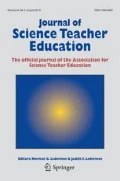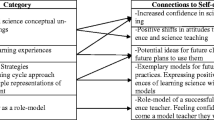Abstract
Self-efficacy beliefs that relate to teachers’ motivation and performance have been an important area of concern for preservice teacher education. Research suggests high-quality science coursework has the potential to shape preservice teachers’ science self-efficacy beliefs. However, there are few studies examining the relationship between science self-efficacy beliefs and science content knowledge. The purpose of this mixed methods study is to investigate changes in preservice teachers’ science self-efficacy beliefs and science content knowledge and the relationship between the two variables as they co-evolve in a specialized science content course. Results from pre- and post-course administrations of the Science Teaching Efficacy Belief Instrument-B (Bleicher, 2004) and a physical science concept test along with semi-structured interviews, classroom observations and artifacts served as data sources for the study. The 18 participants belonged to three groups representing low, medium and high initial levels of self-efficacy beliefs. A repeated measures multivariate analysis of variance design was used to test the significance of differences between the pre- and post-surveys across time. Results indicated statistically significant gains in participants’ science self-efficacy beliefs and science conceptual understandings. Additionally, a positive moderate relationship between gains in science conceptual understandings and gains in personal science teaching efficacy beliefs was found. Qualitative analysis of the participants’ responses indicated positive shifts in their science teacher self-image and they credited their experiences in the course as sources of new levels of confidence to teach science. The study includes implications for preservice teacher education programs, science teacher education, and research.
Similar content being viewed by others
References
American Association for the Advancement of Science. (1993). Benchmarks for science literacy. New York, NY: Oxford University Press.
Appleton, K. (2006). Science pedagogical content knowledge and elementary school teachers. In K. Appleton (Ed.), Elementary science teacher education: International perspectives on contemporary issues and practice (pp. 31–54). Mahwah, NJ: Erlbaum.
Appleton, K., & Kindt, I. (1999). Why teach primary science? Influences on beginning teachers’ practices. International Journal of Science Education, 21, 155–168.
Appleton, K., & Kindt, I. (2002). Beginning elementary teachers’ development as teachers of science. Journal of Science Teacher Education, 13, 43–61.
Avery, L. M., & Meyer, D. Z. (2012). Teaching science as science is practiced: Opportunities and limits for enhancing preservice elementary teachers’ self-efficacy for science and science teaching. School Science and Mathematics, 112, 395–409.
Baldwin, K. A. (2014). The science teaching self-efficacy of prospective elementary education majors enrolled in introductory geology lab sections. School Science and Mathematics, 114, 206–213.
Bandura, A. (1977). Self-efficacy: Toward a unifying theory of behavioral change. Psychological Review, 84(2), 191–215.
Bandura, A. (1982). Self-efficacy mechanism in human agency. American Psychologist, 37, 122–147.
Bandura, A. (1986). Social foundations of thought and action: A social cognitive theory. Englewood Cliffs, NJ: Prentice Hall.
Bandura, A. (1997). Self-efficacy: The exercise of control. New York, NY: Freeman.
Bandura, A., & Wood, R. E. (1989). Effect of perceived controllability and performance standards on self-regulation of complex decision making. Journal of Personality and Social Psychology, 56(5), 805–814.
Banilower, E. R., Smith, P. S., Weiss, I. R., Malzahn, K. A., Campbell, K. M., & Weiss, A. M. (2013). Report of the 2012 national survey of science and mathematics education. Chapel Hill, NC: Horizon Research Inc.
Bautista, N. U. (2011). Investigating the use of vicarious and mastery experiences in influencing early childhood education majors’ self-efficacy beliefs. Journal of Science Teacher Education, 22, 333–349.
Bergman, D. J., & Morphew, J. (2015). Effects of a science content course on elementary preservice teachers’ self-efficacy of teaching science. Journal of College Science Teaching, 44, 73–81.
Bleicher, R. E. (2004). Revisiting the STEBI-B. Measuring self-efficacy in preservice elementary teachers. School Science and Mathematics, 104, 383–391.
Bleicher, R. E., & Lindgren, J. (2005). Success in science learning and preservice science teaching self-efficacy. Journal of Science Teacher Education, 16, 205–225.
Brand, B. R., & Wilkins, J. L. M. (2007). Using self-efficacy as a construct for evaluating science and mathematics methods course. Journal of Science Teacher Education, 18, 297–317.
Bybee, R. W. (1997). Achieving science literacy: From purposes to practices. Portsmouth, NH: Heinemann.
Cakiroglu, J., Capa-Aydin, Y., & Hoy, A. W. (2012). Science teaching efficacy beliefs. In B. J. Fraser, K. Tobin & C. J. McRobbie (Eds.), Second international handbook of science education (pp. 449–461). Netherlands: Springer.
Cantrell, P. (2003). Traditional vs. retrospective pretests for measuring science teaching efficacy beliefs in preservice teachers. School Science and Mathematics, 103, 177–185.
Cantrell, P., Young, S., & Moore, A. (2003). Factors affecting science teaching efficacy of preservice elementary teachers. Journal of Science Teacher Education, 14, 177–192.
Chandrasegaran, A. L., Treagust, D. F., & Mocerino, M. (2007). The development of a two-tier multiple-choice diagnostic instrument for evaluating secondary school students’ ability to describe and explain chemical reactions using multiple levels of representation. Chemistry Education Research and Practice, 8, 293–307.
Chandrasekhar, M., & Kosztin, D. (2012). Exploring physics: Electricity and magnetism and force and motion workbook. Columbia, MO: Department of Physics and Astronomy, University of Missouri.
Cohen, J. (1988). Statistical power analysis for the behavioral sciences. Hillsdale, NJ: Erlbaum.
Corasaro, W. (1981). Entering the child’s world: Research strategies for field entry and data collection in a pre-school setting. In J. Green & C. Wallach (Eds.), Ethnography and language in educational settings. Norwood, NJ: Ablex.
Corsaro, W. A. (1985). Friendship and peer culture in the early years. Norwood, NJ: Ablex.
Crowther, D. T., & Bonnstetter, R. J. (1997). Science experiences and attitudes of elementary education majors as they experience Biology 295: A multiple case study and substantive theory. Paper presented at the Annual Meeting of the National Association for Research in Science Teaching. Oak Brook, IL.
Dembo, M. H., & Gibson, S. (1985). Teachers’ sense of efficacy: An important factor in school improvement. The Elementary School Journal, 86, 173–184.
Engelhardt, P. V., & Beichner, R. J. (2004). Students’ understanding of direct current resistive electrical circuits. American Journal of Physics, 72, 98–115.
Enochs, L. G., & Riggs, I. M. (1990). Further development of an elementary science teaching belief instrument: A preservice elementary scale. School Science and Mathematics, 90, 694–706.
Field, A. (2009). Discovering statistics using SPSS. Thousand Oaks, CA: Sage.
Gist, M. E., & Mitchell, T. R. (1992). Self-efficacy: A theoretical analysis of its determinants and malleability. Academy of Management Review, 17, 183–211.
Gunning, A. M., & Mensah, F. M. (2011). Preservice elementary teachers’ development of self-efficacy and confidence to teach science: A case study. Journal of Science Teacher Education, 22, 171–185.
Guskey, T. R., & Passaro, P. D. (1994). Teacher efficacy: A study of construct dimensions. American Educational Research Journal, 31, 627–643.
Hechter, R. P. (2011). Changes in preservice elementary teacher’s personal science teaching efficacy and science teaching outcome expectancies: The influence of context. Journal of Science Teacher Education, 22, 187–202.
Hestenes, D., Wells, M., & Swackhamer, G. (1992). Force concept inventory. The Physics Teacher, 30(3), 141–158.
Jarrett, O. (1999). Science interest and confidence among preservice elementary teachers. Journal of Elementary Science Education, 11, 47–57.
Kazempour, M., & Sadler, T. D. (2015). Pre-service teachers’ beliefs, attitudes, and self-efficacy: A multi-case study. Teaching Education, 26, 247–271. doi:10.1080/10476210.2014.996743
Knaggs, C. M., & Sondergeld, T. A. (2015). Science as a learner and as a teacher: Measuring science self-efficacy of elementary preservice teachers. School Science and Mathematics, 115, 117–128.
Leonard, J., Barnes-Johnson, J., Dantley, S. J., & Kimber, C. (2011). Teaching science inquiry in urban contexts: The role of elementary preservice teachers’ beliefs. Urban Review, 43, 124–150.
Levine, T. R., & Hullett, C. R. (2002). Eta squared, partial eta squared and misreporting of effect size in communication research. Human Communication Research, 28, 612–625.
Morse, J. M., & Niehaus, L. (2009). Mixed method design: Principles and procedures. Walnut Creek, CA: Left Coast Pr.
Mulholland, J., & Wallace, J. (1996). Breaking the cycle: Preparing elementary teachers to teach science. Journal of Elementary Science Education, 8(1), 17–38.
Mulholland, J., & Wallace, J. (2001). Teacher induction and elementary science teaching: Enhancing self-efficacy. Teacher and Teacher Education, 17, 243–261.
Narayan, R., & Lamp, D. (2010). “Me? Teach science?” Exploring EC-4 preservice teachers’ self-efficacy in an inquiry-based constructivist physics classroom. Educational Research and Reviews, 5(12), 748–757.
National Research Council (NRC). (1996). National science education standards. Washington, DC: National Academy Press.
National Research Council (NRC). (2012). A framework for K-12 science education: Practices, crosscutting concepts, and core ideas. Washington, DC: National Academic Press.
Nespor, J. (1987). The role of beliefs in the practice of teaching. Journal of Curriculum Studies, 19, 328–371.
Next Generation Science Standards (NGSS) Lead States. (2013). Next Generation Science Standards: For states, by states. Washington, DC: National Academics Press.
Nunnally, J. C., & Bernstein, I. H. (1994). Psychometric theory. New York, NY: McGraw-Hill.
O’Brien, R. G., & Kaiser, M. K. (1985). MANOVA method for analyzing repeated measures designs: An extensive primer. Psychological Bulletin, 97(2), 316.
Osterlind, S. J. (2006). Modern measurement: Theory, principles, and applications of mental appraisal. Upper Saddle River, NJ: Pearson/Merrill Prentice Hall.
Pajares, M. F. (1992). Teachers’ beliefs and educational research: Cleaning up a messy construct. Review of Educational Research, 62, 307–333.
Palmer, D. (2006a). Durability of changes in self-efficacy of preservice primary teachers. International Journal of Science Education, 28, 655–671.
Palmer, D. (2006b). Sources of self-efficacy in a science methods course for primary teacher education students. Research in Science Education, 36, 337–353.
Ramey-Gassert, L., & Shroyer, M. G. (1992). Enhancing science teaching self-efficacy in preservice elementary teachers. Journal of Elementary Science Education, 4(1), 26–34.
Ramey-Gassert, L., Shroyer, M. G., & Staver, J. R. (1996). A qualitative study of factors influencing science teaching self-efficacy of elementary level teachers. Science Education, 80, 283–315.
Rice, D. C., & Roychoudhury, A. (2003). Preparing more confident preservice elementary science teachers: One elementary science methods teacher’s self-study. Journal of Science Teacher Education, 14, 97–126.
Riggs, I. M., & Enochs, L. G. (1990). Toward the development of an elementary teacher’s science teaching efficacy belief instrument. Science Education, 74, 625–637.
Settlage, J. (2000). Understanding the learning cycle: Influences on abilities to embrace the approach by preservice elementary school teachers. Science Education, 84, 43–50.
Strauss, A., & Corbin, J. (1988). Basics of qualitative research: Techniques and procedures of developing grounded theory. Thousand Oaks, CA: Sage.
Tashakkori, A., & Teddlie, C. (2010). Sage Handbook of mixed methods in social and behavioral research. Thousand Oaks, CA: Sage.
Tosun, T. (2000). The impact of prior science course experience and achievement on the science teaching self-efficacy of preservice elementary teachers. Journal of Elementary Science Education, 12(2), 21–31.
Trigstad, P. J., Smith, P. S., Banilower, E. R., & Nelson, M. M. (2013). The status of elementary science education: Are we ready for the Next Generation Science Standards? Retrieved from http://www.horizonresearch.com/2012nssme/wpccontent/uploads/2013/06/The-Status-of-Elementary-Science-Education_paper.pdf
Tschannen-Moran, M., Hoy, A. W., & Hoy, W. K. (1998). Teacher efficacy: Its meaning and measure. Review of Educational Research, 68, 202–248.
Velthuis, C., Fisser, P., & Pieters, J. (2014). Teacher training and pre-service primary teachers’ self-efficacy for science teaching. Journal of Science Teacher Education, 25, 445–464.
Watters, J. J., & Ginns, I. S. (2000). Developing motivation to teach elementary science: Effect of collaborative and authentic learning practices in preservice education. Journal of Science Teacher Education, 11, 301–321.
Yoon, S., Pedretti, E., Pedretti, L., Hewitt, J., Perris, K., & Van Oostveen, R. (2006). Exploring the use of cases and case methods in influencing elementary preservice science teachers’ self-efficacy beliefs. Journal of Science Teacher Education, 17, 15–35.
Author information
Authors and Affiliations
Corresponding author
About this article
Cite this article
Menon, D., Sadler, T.D. Preservice Elementary Teachers’ Science Self-Efficacy Beliefs and Science Content Knowledge. J Sci Teacher Educ 27, 649–673 (2016). https://doi.org/10.1007/s10972-016-9479-y
Published:
Issue Date:
DOI: https://doi.org/10.1007/s10972-016-9479-y




